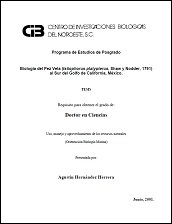In vitro digestibility of specific dsRNA by enzymes of digestive tract of shrimp Litopenaeus vannamei
Digestibilidad in vitro del dsRNA específico por enzimas del tracto digestivo del camarón Litopenaeus vannamei
Autor
ANA RUTH ALVAREZ SANCHEZ
HECTOR GERARDO NOLASCO SORIA
CLAUDIO HUMBERTO MEJIA RUIZ
Metadatos
Mostrar el registro completo del ítemResumen
"The digestibility of specific dsRNA by action of the enzymes of digestive tract of the whiteleg shrimp Litopenaeus vannamei was determined in vitro. Materials and methods. Digestive enzyme activity (amylase, lipase, protease, DNase and RNase) was measured in the stomach, digestive gland, and anterior, middle, and posterior intestine of juvenile shrimp, and the digestibility of DNA, RNA and the dsRNA-ORF89, specific to WSSV, was determined by in vitro assays, as well as electrophoretic and densitometric analyses. Results. The highest enzymatic activity was found in the digestive gland: amylase (81.41%), lipase (92.60%), protease (78.20%), DNase (90.85%), and RNase (93.14%). The highest digestive capacity against DNA, RNA, and dsRNA was found in the digestive gland (5.11 ng of DNA per minute, 8.55 ng of RNA per minute, and 1.48 ng dsRNA per minute). Conclusions. The highest digestibility of dsRNA-ORF89, specific to WSSV, was found in the digestive gland, whereas the lowest digestibility was observed in the posterior intestine. This is the first report regarding the digestibility of dsRNA-ORF89 by whiteleg shrimp digestive tract enzymes, with potential therapeutic importance in shrimp culture to prevent WSSV disease through balanced feed." "La digestibilidad del dsRNA específico para el virus de la mancha blanca (WSSV) por acción de las enzimas del tracto digestivo del camarón Litopenaeus vannamei fue analizada in vitro. Material y métodos. Se midió la actividad de enzimas digestivas (proteasa, amilasa, lipasa, ADNasa y ARNasa) en el estómago, la glándula digestiva, el intestino anterior, medio y posterior en juveniles de camarón patiblanco y se evaluó la digestibilidad de ácidos nucleicos ADN, ARN y dsRNA-ORF89 especifico contra el virus WSSV, por análisis electroforéticos y densitometría. Resultados. La actividad enzimática más alta se encontró en la glándula digestiva del camarón: amilasa (81.41%), lipasa (92.60%), proteasa (78.20%), ADNasa (90.85%) y ARNasa (93.14%). Se evidenció la capacidad digestiva del camarón patiblanco contra el ADN, ARN y dsRNA-ORF89 encontrando en la glándula digestiva la mayor digestión (5.11 ng de ADN por minuto, 8.55 ng de ARN por minuto y 1.48 ng de dsRNA por minuto). Conclusiones. La mayor digestibilidad del dsRNA-ORF89, específico contra el virus WSSV, se encontró en la glándula digestiva y la menor en el intestino posterior. Este es el primer informe relacionado con la digestibilidad del dsRNA-ORF89 por las enzimas del camarón patiblanco con potencial importancia terapéutica en el cultivo de camarón para prevenir la enfermedad del WSSV a través del alimento balanceado."
Colecciones
Ítems relacionados
Mostrando ítems relacionados por Título, autor o materia.
-
PROMOCIÓN DEL PERIFITON PARA EL CULTIVO DE CAMARÓN BLANCO: HACIA UNA ACUICULTURA ECOLÓGICA
DOMENICO VOLTOLINA LOBINA; JUAN MANUEL AUDELO NARANJO; MARIA DEL ROSARIO PACHECO MARGES -
Suelo y Erosión
YOLANDA LOURDES MAYA DELGADO


